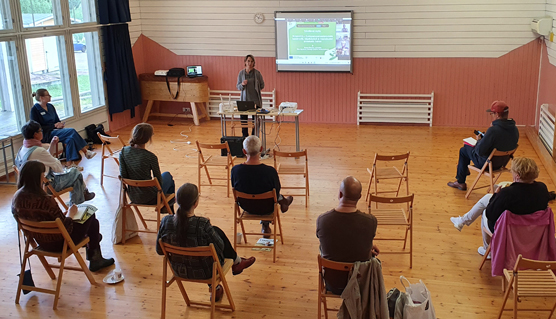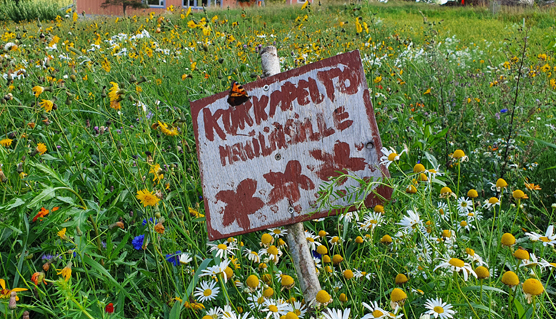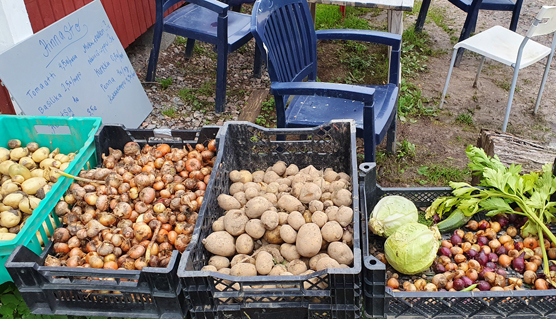
Partly webinar and partly face-to-face CSA meeting on 5 September 2020. © Anni Turunen
The Community Supported Agriculture (CSA) meeting considered the possibility of taking into account the economic or social situation of its members in the crop payments collected from them, while also ensuring an adequate livelihood for producers.
Various payment models for CSA were discussed at an event held on 5 September 2020 in the Urban Cooperative FarmFood coop (Kaupunkilaisten oma pelto) in Vantaa. The workshop-type meeting was part of the Just Food project research and collected material to support the development of new payment models. Rita Amundsen, a long-term CSA farmer from Øverland Andelslandbruk in Norway, and Sebastian Klein from the German CSA network Netzwerk Solidarische Landwirtschaft, as well as Olli Repo from the Urban Cooperative FarmFood coop shared practical experiences from different payment models. The participants who were on site also got a tour of the field to see the Urban Cooperative FarmFood coop.
All parties had made the same observation: because of the COVID-19 situation, the debate on community supported agriculture has been more lively again this year. People are now clearly more interested in food security and self-sufficient food production. The topics of organic and local food have also been on the rise. “Surprisingly, twelve new community supported agriculture partners have started in Norway this year, people are really interested in where food comes from,” says Amundsen. Hence, this is also a good time to talk about developing payment models for CSA.
Payment models are not just about money
In Community Supported Agriculture (CSA), the consumer members pay the producers a pre-agreed price for the products of the net crop season, which are available to them throughout the crop season. Often, the members also take part in working on the field. In the traditional CSA models, the annual crop share fee is the same for everyone, regardless of the earnings of the members. The model does not take into account the socio-economic situation of different members. This may have limited the participation of disadvantaged groups in community supported agriculture.
There are differences between the Finnish, Norwegian and German community supported agriculture models, but all participants agreed that it is not just about money or merely buying and selling food, but also about sharing farm products – in good and bad times.
Good experiences have been gained with new payment models. In Norway, for example, a payment based on three different levels has been tested with a normal fee, or, depending on the member’s situation, either a slightly lower or higher fee.
In Germany, the variation in fees is even greater. Sebastien Klein, a pioneer in community supported agriculture and a beekeeper in Germany, explained that their basic idea is that there is no price for food, but there are costs involved in food production. Thus, the payments are based on the production costs, and each member decides on the amount he/she wants to contribute. In the initial bidding round, members bid the amounts they are willing to pay for the upcoming costs by themselves. When the sum of the bids of all members equals the cost for annual cultivation, the call for tenders may be accepted. In this way, the production costs have been distributed according to the solvency of the members.
In addition, cheaper or free shares have been tried by different groups. Community supported a people from very different backgrounds who are interested in starting their own cultivation activities, such as people in re-training, students in the field of agriculture, activists interested in organic and environmental issues, and immigrants. “We have learned a lot from our members with immigrant backgrounds, both in agriculture and in the use of products,” Amundsen says.

"A field for bees only". © Anni Turunen
New sources of funding and new technology
Good practice has also been obtained by setting up various projects with external project funding, such as groups related to cultivating herbs, flowers and taking care of bees and chickens. It has been possible to share this supplementary yield on top of the yield of the basic crops among all members.
Klein also spoke about how new technologies can be utilised in the funding models of community supported agriculture. They had developed a mobile app for online bidding to optimise the organisation of the funding round.
Democracy and solidarity at the heart of action
Fair payment models for crop payments can be developed in collaboration with members. It is typical that actors involved in the community supported agriculture have different opinions and suggestions on how things could be developed. It is in the spirit of community supported agriculture that everyone is listened to equally. Networking amongst members and in-depth guidance for new members facilitate collaboration and bring transparency to operations. Amundsen, Klein and Repo list concrete examples to strengthen cooperation:
- clear written and long-term contracts,
- good cultivation plan,
- organised administration, budget plan, annual meetings,
- communication through, for example, newsletters and websites,
- training and information packages,
- meetings,
- good communication in potential conflict situations.

Some of the most bountiful crops were shared free to all farmers. © Anni Turunen
Would you like to join?
The CSA is not yet so well known in Finland, we currently have a dozen Community Supported Agriculture partners in different parts of Finland. So there is still room for action. “We need members who can commit to the activity for a longer period of time, so we can also guarantee producers the necessary livelihood. I believe that if we get people to the fields to see where food really comes from, interest in Community Supported Agriculture will also arise,” says Repo.
The event was co-organised by the Just Food project, Kumakka project working on the sustainability, competitiveness and appreciation of agriculture in community supported agriculture, and the community supported agriculture actor Urban Cooperative FarmFood coop. The following also spoke on the subject: Susann Rännäri from the Finnish Organic Association, Rita Amundsen from Øverland Andelslandbruk in Norway and Sebastian Klein from the German community supported agriculture network Netzwerk Solidarische Landwirtschaft. A more detailed description of the day’s events can be found on the Oma pelto blog. Many thanks to all participants for the lively discussion!
Read more
More information
- Postdoctoral Researcher Riikka Aro, University of Jyväskylä, firstname.lastname@jyu.fi
- Ritva Mynttinen, Kumakka-project, ritva.mynttinen@helsinki.fi
- Olli Repo, the Urban Co-operative FarmFood co-op, olirepo@gmail.com